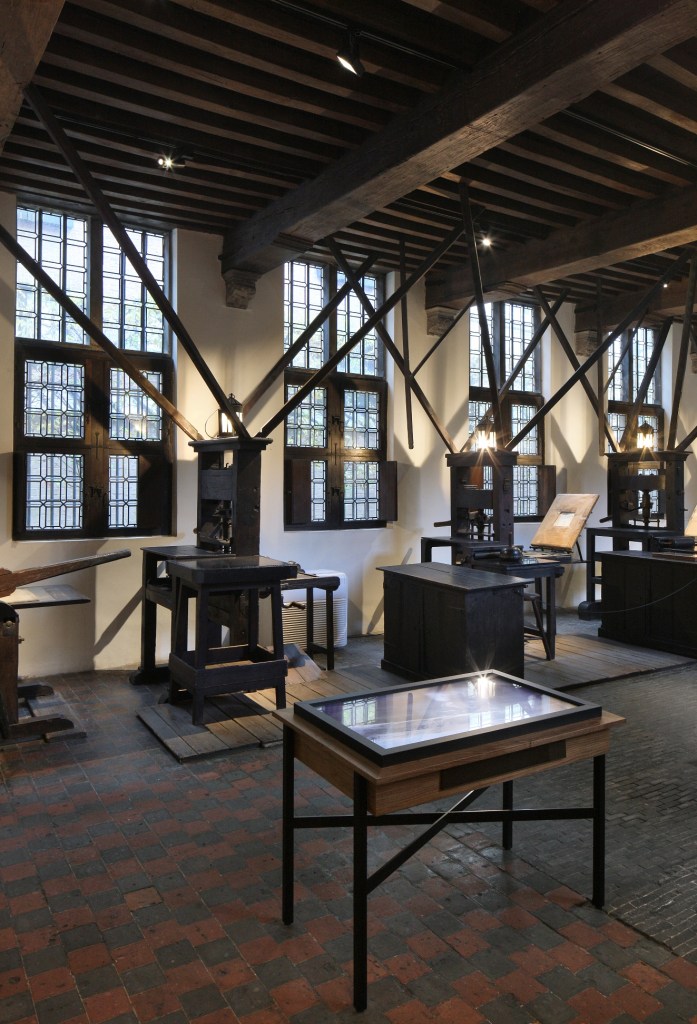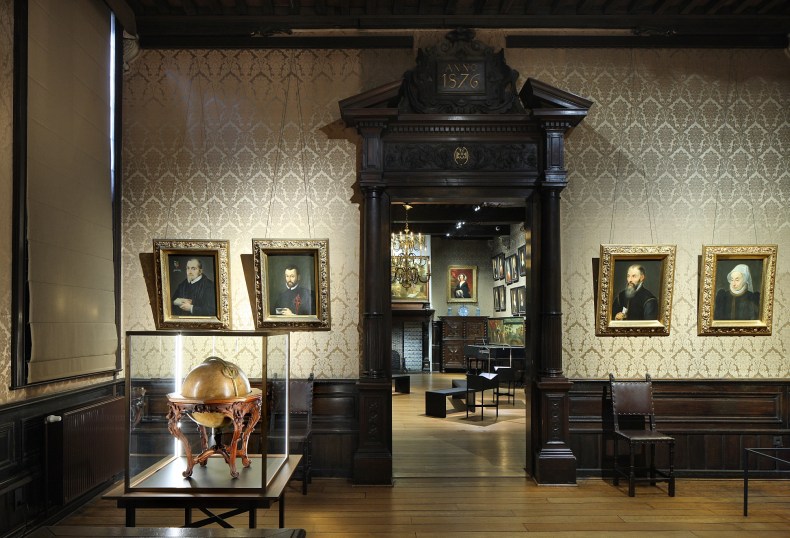In Antwerp, on the narrow Heilige Geeststraat, the blind, beamed compartments of a new façade – designed by the artist Benoît van Innis and built by noAarchitecten of Brussels in 2016 – suggest on a magnified scale a piece of early modern hardware: the box known as a type case, in which metal pieces of moveable type were stored before being set by compositors ready for printing. The façade’s wooden grid is boldly expressive of the building’s contents, for behind it lie a reading room and the most extensive archive of early modern printing in Europe. This is the latest addition to the complex of buildings that forms the Plantin-Moretus Museum, dedicated since 1876 to the history of the publishing firm, and occupying the site first developed in the 1570s by its founder, the great printer Christophe Plantin. With its new storage and study space, and a demurely reconceived public presentation, the museum reopened in September.

Printing factory at the Plantin-Moretus Museum. Photo: Filip Dujardin
At its height, the Officina Plantiniana (which continued for 300 years after Plantin’s death under his successors, the Moretuses) operated 16 presses, each manned by two printers who could print an unparalleled 2,500 sheets a day. While master printers like Plantin belonged to the artists’ guild of St Luke, the firm’s permanent workforce of 60 was organised into an internal union called the Kapel (the ‘Chapel’), which provided healthcare and regulated conditions. You sense their labour in the press room on the ground floor of the south range. Here, rows of sloping type cases face the presses, their levers raised in the air, their repetitive forms suggestive of what was so revolutionary about this technology: reproducibility. Above the two oldest surviving presses in the world sits a terracotta Virgin Mary – the spotless matrix herself presiding over a room devoted to impressing virgin-white sheets of the finest paper.
Displayed directly above her on the upper floor is a work that encapsulates the ambition of the Plantin enterprise: the Polyglot Bible, produced between 1568–72 in a combination of Hebrew, Greek, Aramaic, Syriac, and Latin, and funded by Philip II of Spain. This was a monumental undertaking, drawing on materials and scholarly research from across Europe. It secured Plantin the lucrative contract of supplying Spain and its Latin American colonies with prayer books. There’s a conscious effort elsewhere in the museum to situate the Plantin Press in a global context, both in terms of the dissemination and the contents of its products. In the 1570s and ’80s, Plantin published editions of the first atlas, Abraham Ortelius’s Theatrum orbis terrarum, which is exhibited in a room full of other horizon-expanding cartographic works.
But the first rooms you enter on the circuit emphasise that most local of units, the family. This is the grand 17th-century wing built by the third head of the business, Balthasar I Moretus, as living quarters. Rows of portraits, including many by Balthasar’s friend Rubens, tell the story of a family’s rise from black cloth and modest white ruffs to pearls, coloured silks, and lace. They are a reminder of the crucial role played by the family’s women; Plantin’s daughters, schooled in Latin and Greek, helped with proofreading as well as bookkeeping. Anna Goos, wife of Balthasar II, took over the management in 1673. There were strategic marriages: Theodor Galle married Jan Moretus’s daughter Catherine in 1598. It was the Galles, renowned as print publishers, who printed the illustrations to the Officina’s books, since the presses required for text and images were quite different.

The Plantin-Moretus Museum, Antwerp. Photo: Filip Dujardin
Plantin and his successors understood that a good business, like a family, needs a myth. Their symbol was a golden compass, their motto Labore et Constantia: one arm of the compass stays steady while the other traces an arc. If you look up at the stone corbels throughout the buildings, you see that compass carved there. It alternates with the stella duce, the star that guided the Kings to Bethlehem. This was the emblem of Balthasar I, who commissioned ‘portraits’ of the Magi from Rubens to hang among the family pictures. There’s a sense of destiny in this identification, like the Virgin in the press room, a constant reminder of a higher calling. Rubens’ sobering Seneca hangs in the chamber of the firm’s humanist friend Justus Lipsius. Yet, like the sumptuous Cordovan leather of this room’s walls, austere stoicism coexisted with ostentatious exceptionalism: ‘I don’t print for the same price as other printers,’ said Balthasar, ‘as Rubens doesn’t paint for the same price as other painters.’
The flashiest component of the new installation is a series of high-definition flat-screens, looping films that use actors to imagine the people who lived and worked here. With Bill Viola slowness, you see the careful tying of book bundles in linen, or the reading of a young girl. In the press room, you see the setting, inking, and printing of text by blackened hands. You drink in the pleasure of process, just as elsewhere you can leaf through sample pages of different papers and parchments like a prospective customer. ‘Materiality’ is the art-historical keyword; the more digital we get, the more we’re aware of the physicality of objects and their making. This museum is animated by that dialectic, but it’s a place where historical imagination might help us avoid pure fetishism of the handmade.
From the February 2017 issue of Apollo: subscribe here.

‘A good business, like a family, needs a myth’
Portraits of Christophe Plantin (1616) and Jan I Moretus (1613/16) by Peter Paul Rubens. Plantin-Moretus Museum, Antwerp
Share
In Antwerp, on the narrow Heilige Geeststraat, the blind, beamed compartments of a new façade – designed by the artist Benoît van Innis and built by noAarchitecten of Brussels in 2016 – suggest on a magnified scale a piece of early modern hardware: the box known as a type case, in which metal pieces of moveable type were stored before being set by compositors ready for printing. The façade’s wooden grid is boldly expressive of the building’s contents, for behind it lie a reading room and the most extensive archive of early modern printing in Europe. This is the latest addition to the complex of buildings that forms the Plantin-Moretus Museum, dedicated since 1876 to the history of the publishing firm, and occupying the site first developed in the 1570s by its founder, the great printer Christophe Plantin. With its new storage and study space, and a demurely reconceived public presentation, the museum reopened in September.
Printing factory at the Plantin-Moretus Museum. Photo: Filip Dujardin
At its height, the Officina Plantiniana (which continued for 300 years after Plantin’s death under his successors, the Moretuses) operated 16 presses, each manned by two printers who could print an unparalleled 2,500 sheets a day. While master printers like Plantin belonged to the artists’ guild of St Luke, the firm’s permanent workforce of 60 was organised into an internal union called the Kapel (the ‘Chapel’), which provided healthcare and regulated conditions. You sense their labour in the press room on the ground floor of the south range. Here, rows of sloping type cases face the presses, their levers raised in the air, their repetitive forms suggestive of what was so revolutionary about this technology: reproducibility. Above the two oldest surviving presses in the world sits a terracotta Virgin Mary – the spotless matrix herself presiding over a room devoted to impressing virgin-white sheets of the finest paper.
Displayed directly above her on the upper floor is a work that encapsulates the ambition of the Plantin enterprise: the Polyglot Bible, produced between 1568–72 in a combination of Hebrew, Greek, Aramaic, Syriac, and Latin, and funded by Philip II of Spain. This was a monumental undertaking, drawing on materials and scholarly research from across Europe. It secured Plantin the lucrative contract of supplying Spain and its Latin American colonies with prayer books. There’s a conscious effort elsewhere in the museum to situate the Plantin Press in a global context, both in terms of the dissemination and the contents of its products. In the 1570s and ’80s, Plantin published editions of the first atlas, Abraham Ortelius’s Theatrum orbis terrarum, which is exhibited in a room full of other horizon-expanding cartographic works.
But the first rooms you enter on the circuit emphasise that most local of units, the family. This is the grand 17th-century wing built by the third head of the business, Balthasar I Moretus, as living quarters. Rows of portraits, including many by Balthasar’s friend Rubens, tell the story of a family’s rise from black cloth and modest white ruffs to pearls, coloured silks, and lace. They are a reminder of the crucial role played by the family’s women; Plantin’s daughters, schooled in Latin and Greek, helped with proofreading as well as bookkeeping. Anna Goos, wife of Balthasar II, took over the management in 1673. There were strategic marriages: Theodor Galle married Jan Moretus’s daughter Catherine in 1598. It was the Galles, renowned as print publishers, who printed the illustrations to the Officina’s books, since the presses required for text and images were quite different.
The Plantin-Moretus Museum, Antwerp. Photo: Filip Dujardin
Plantin and his successors understood that a good business, like a family, needs a myth. Their symbol was a golden compass, their motto Labore et Constantia: one arm of the compass stays steady while the other traces an arc. If you look up at the stone corbels throughout the buildings, you see that compass carved there. It alternates with the stella duce, the star that guided the Kings to Bethlehem. This was the emblem of Balthasar I, who commissioned ‘portraits’ of the Magi from Rubens to hang among the family pictures. There’s a sense of destiny in this identification, like the Virgin in the press room, a constant reminder of a higher calling. Rubens’ sobering Seneca hangs in the chamber of the firm’s humanist friend Justus Lipsius. Yet, like the sumptuous Cordovan leather of this room’s walls, austere stoicism coexisted with ostentatious exceptionalism: ‘I don’t print for the same price as other printers,’ said Balthasar, ‘as Rubens doesn’t paint for the same price as other painters.’
The flashiest component of the new installation is a series of high-definition flat-screens, looping films that use actors to imagine the people who lived and worked here. With Bill Viola slowness, you see the careful tying of book bundles in linen, or the reading of a young girl. In the press room, you see the setting, inking, and printing of text by blackened hands. You drink in the pleasure of process, just as elsewhere you can leaf through sample pages of different papers and parchments like a prospective customer. ‘Materiality’ is the art-historical keyword; the more digital we get, the more we’re aware of the physicality of objects and their making. This museum is animated by that dialectic, but it’s a place where historical imagination might help us avoid pure fetishism of the handmade.
From the February 2017 issue of Apollo: subscribe here.
Unlimited access from just $16 every 3 months
Subscribe to get unlimited and exclusive access to the top art stories, interviews and exhibition reviews.
Share
Recommended for you
Why the Israel Museum is searching for a new director… again
Weeks after Eran Neuman took up the directorship, he left. What’s going on at the Israel Museum?
The Met considers levying entrance fee
Art News Daily : 27 April
Plans for Berlin’s Museum of the 20th Century criticised
Art News Daily : 26 April